Summertime is upon us now and with it comes loads of people participating in outdoor activities like hiking, sports, camping and activities on the water. Everyone looks forward to warmer weather after winter but some of those activities can impact birds and wildlife.
I photographed the Reddish Egret above in May of 2009 at Fort De Soto Count Park’s north beach. It was a warm morning and I was inside a lagoon kneeling on my knees while the egret was hunting, the action was intense and there were times the egret came in very close to me, it was so exciting and quick that I barely had time to make sure my exposure was okay before I fired off shot after shot of the Reddish Egret. I really liked this pose with the wings lifted, the great eye contact, the background and the beautiful light. It is a wonderful image… until you look closer.
This is the same image, I have just drawn lines to indicate what I saw when I got home and brought the series of images of this Reddish Egret up on my monitor. Every red line shows an area where some type of motor oil had saturated the Reddish Egret’s plumage. The marina isn’t too far from where I photographed this handsome wading bird as a crow flies and I suspect that there was a boat leaking oil that this egret inadvertently got into. The tips of the primaries were saturated, some of the secondaries, tail feathers and coverts also were coated in oil.
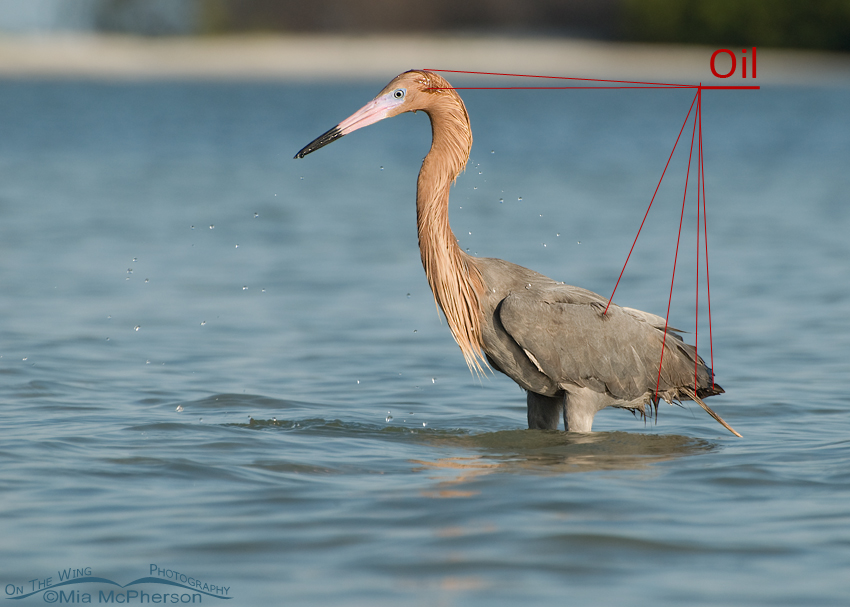 Pointing to the oil on a Reddish Egret
Pointing to the oil on a Reddish Egret
This image shows the oil saturated tail, the feathers near the vent, the upper scapulars and on top of the bird’s head. Reddish Egrets are often in water that reaches their under sides when they are actively hunting which means their tail and ventral area come in direct contact with the water and oils which are lighter than water will form a film on it and when it comes in contact with a birds feathers gets soaked up by them. Also while Reddish Egrets are hunting they push their heads under the water to get their prey which explains how the oil came to be on the egret’s head.
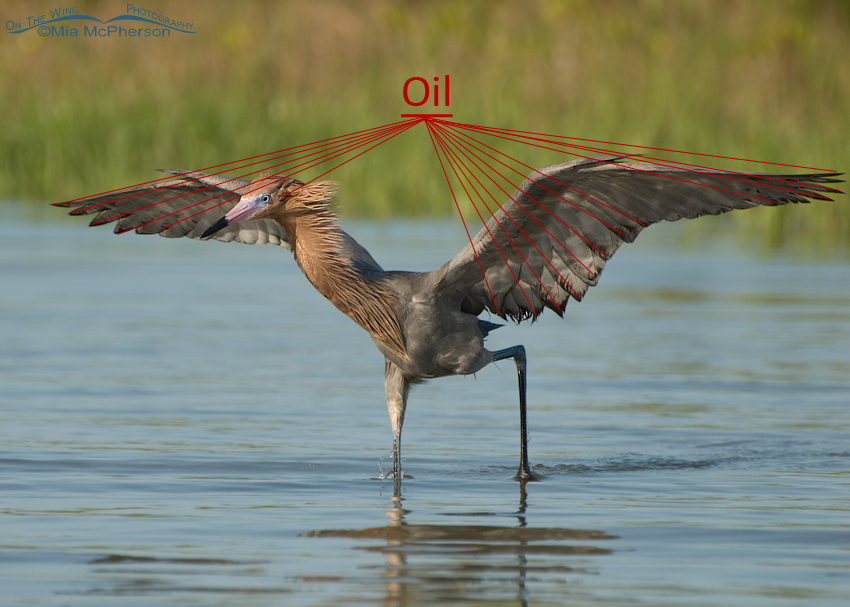 A different view of the Oil on the Reddish Egret
A different view of the Oil on the Reddish Egret
This view shows the dark stain of the oil and it also shows how matted the feathers were because of the oil. Even a quart of oil spread over a wide area of water can cause huge problems for the birds and wildlife that come in contact with it. The oil is poison, I won’t sugar coat that fact. It is poison to wildlife and it is poison to us. This bird got the oil on it in the same water that children would swim in.
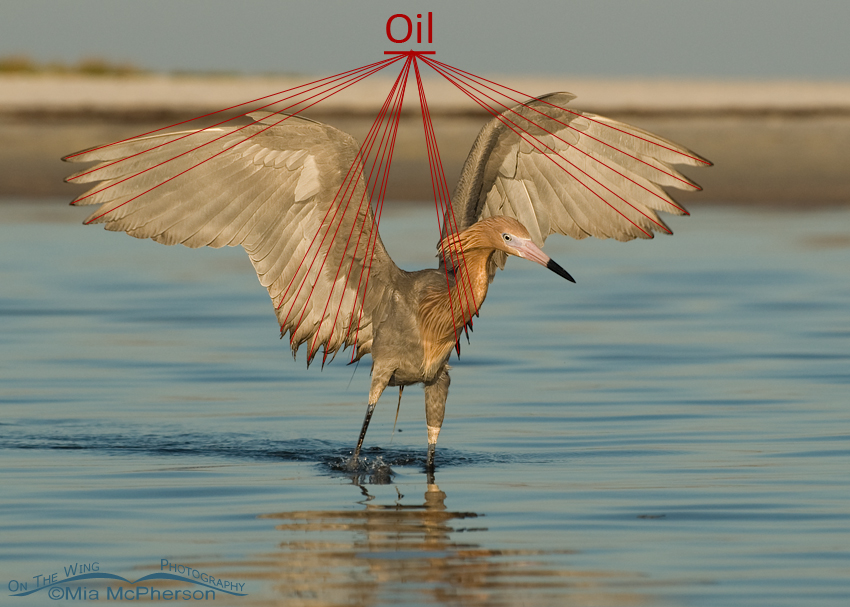 The same Reddish Egret a week later
The same Reddish Egret a week later
This is an image of the same bird a week later, the darkness of the oil isn’t as evident on the primaries or the head but there is still oil stained and matted secondaries. Egret usually preen several times a day and this egret’s bill would have come into contact with those oily feathers which means the bird also ingested the oil which is poisonous. The egret eventually got the oil off and it did survive but many other animals that come into contact with oils don’t.
I hope that boaters will be careful this summer and not pollute our precious waters or poison the wildlife that depends on it. Our recreation shouldn’t endanger wildlife.
Mia
The oiled bird was reported to Jim Wilson, the park supervisor. During that period of a week I did see two other birds; a White Ibis and a Yellow-crowned Night Heron, with a small amount of oil on them. This situation could have been much worse.


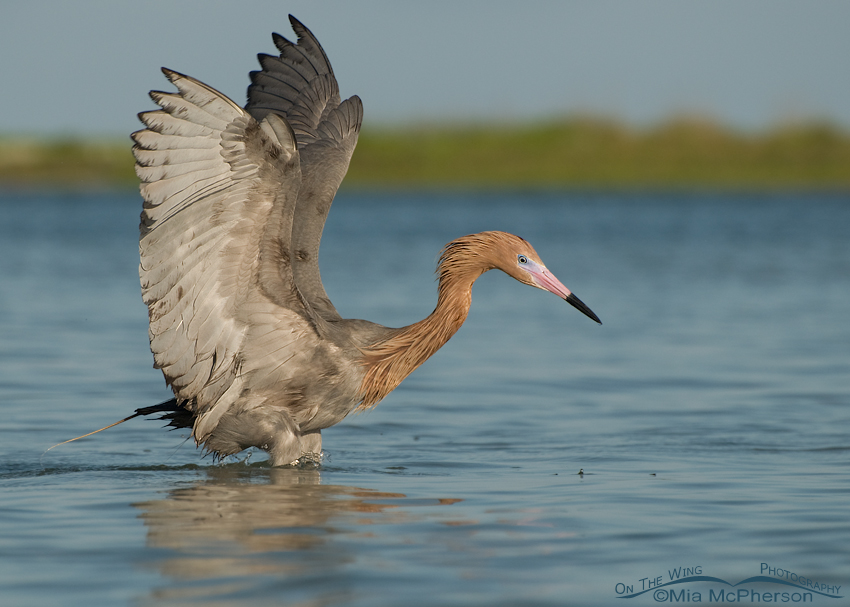
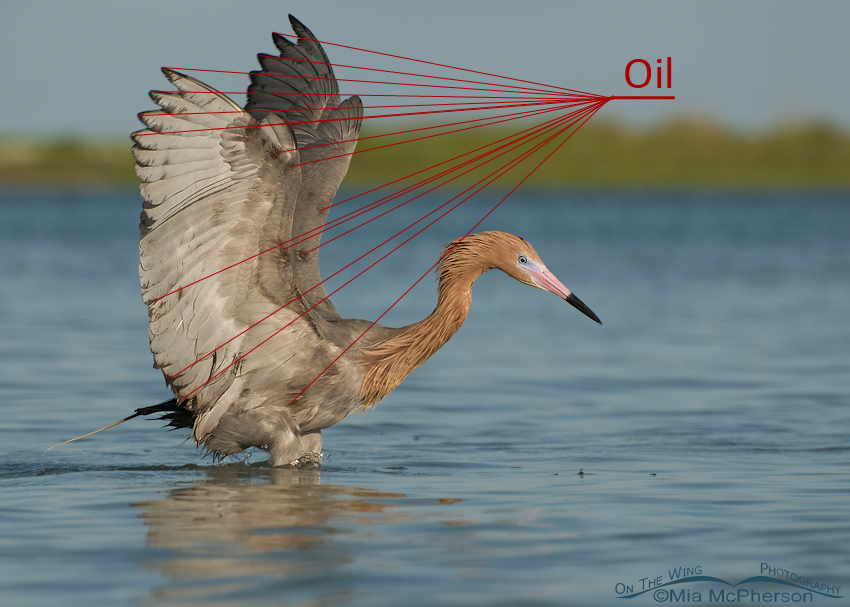



I dread seeing those images after I offload — traces of oil on the plumage. The best analogy I was taught was that oil on the feathers is like a hole in a wetsuit. Anything that breaks the seal of those perfectly aligned feathers and barbs is often lethal, especially for pelagic or water-bound birds who are then susceptible to hypothermia. The worst part is that birds with just a light coating are impossible to capture for treatment. It’s usually only after they suffer the effects of the oil that they’re weak enough to capture and transports.
Ingrid, even the small amount of oil on the egret affected it. I worried about this bird for weeks and hoped I would not come across it dead. Fortunately it was warm and I didn’t worry so much about hypothermia. Oil + wildlife = a bad combination.
Another informative post, Mia. Good to know that the egret had recovered somewhat and that you were able to report the problem to someone in authority.
Thank you Julie.
Terrific photos, Mia! I wish people would use more care when dealing with oil, especially around water.
Thanks Charlotte, I wish more people would be careful too.
Great shots Mia — egrets are one of my favorite birds, because they so remind me of their dinosaur cousins who went extinct over 65 million years ago; in fact, i have one on my supporting wildlife UT license plate. Thanks for sharing these revealing images and for reporting the oil problem. Once again we learn so much from your postings. Keep up the good work!
Thank you Utahbooklover, egrets are wonderful & fascinating!
This is unacceptable. I sure do hope the egret is okay. It is a very interesting photographic study on the way the oil adheres to the feathers.
Maria, this egret was okay.
so nice poses for your pictures, i imagine your excitation when you did it… and after the bad surprise of the details on feather with a oil pollution, it s a big shame… is it possible to do action / inofrmation to prevent it ?
take care mia
Thank you Eric. I know that at Fort De Soto they take every action they can to prevent oil pollution and I am sure many other places in the US do too. All it takes though is one careless spill to affect the wildlife in the area.
These are wonderful (and very sad) photographs of a beautiful bird. It would be great if people woke up and became concerned about their impact on wildlife.
Thanks Lynn, I hope that awareness of the issues we cause for wildlife will be more prevalent in the future.
These are great images and I think they should be used to educate more!!! Everyone thinks of big oil spills and corporations but we often forget about the people that spill (or dump) oil in or near waterways while boating or just because they won’t take their car oil where it should go.
Thanks Sherry, even small oil spills can impact wildlife in dramatic ways.
The beauty of your incredible images makes this tragedy all the more poignant. Thank you Mia!
Thank you Carol. What worries me is that this can easily happen on any river, stream, lake, marsh, swamp or salt water estuaries, bays and open water.